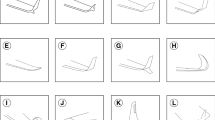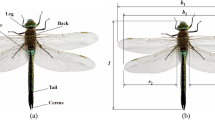Abstract
In the present paper, computational analysis has been carried out to assess the coupled fluid–structure interaction using NASTRAN finite element approach. A straight swept wing of aluminum material is studied at transonic zone. Analysis has been carried out to find the natural frequency by fluid–structure interaction, then adopting its natural frequency to calculate the reduced frequency for analyzing the flutter effectiveness. A typical case study of plate has been carried out for better understanding the flutter which was then adopted for the swept wing. A fluid–structure interaction phenomenon provides an additional energy to the moving object in terms of frequency in transonic zone. In this speed zone, the divergence speed results a drag that leads to the object to be in a stronger twisting mode resulting in catastrophic failure of the aircraft. The study has defined the flutter boundary of the wing in terms of velocity and frequency which will be very useful in preventing the flutter failure of the aircraft wing through appropriate design improvement or through restriction operational regime.


















Similar content being viewed by others
References
H.J.-P. Morand, O. Roger, Fluid Structure Interaction (Wiley, Hoboken, 1995)
L.C. Freudinger, Flutter Clearance of the F-18 High-Angle-of-Attack Research Vehicle with Experimental Wingtip Instrumentation Pods (NASA Dryden Flight Research Center, Edwards, 1989)
C.E. Lemley, Design Criteria for the Prediction and Prevention of Panel Flutter, vols. I and II, Air Force Flight Dynamics Laboratory, Write-Patternson Air Force Base, Ohio, AFFDL-TR-67-140 (1968)
S.J. Pollock et al., Evaluation of methods for prediction and prevention of wing/store flutter. J. Aircr. 19(6), 492–498 (1982)
E.M. Lee-Rausch, J.T. Batina, Wing flutter boundary prediction using unsteady Euler aerodynamic method. J. Aircr. 32(2), 416–422 (1995)
F. Liu et al., Calculation of wing flutter by a coupled fluid–structure method. J. Aircr. 38(2), 334–342 (2001)
C. Grandmont, Y. Maday, Existence for an unsteady fluid–structure interaction problem. ESAIM 34(3), 609–636 (2000)
J. Zeng et al., Ground Vibration Test Identified Structure Model for Flutter Envelope Prediction. AIAA Atmospheric Flight Mechanics Conference 2012
W. Chajec, Flutter calculation based on GVT-results and theoretical mass model. Aviation 13(4), 122–129 (2009)
A.C. Pankaj et al., Aircraft flutter prediction using experimental modal parameters. Aircr. Eng. Aerosp. Technol. 85(2), 87–96 (2013)
E. Lee-Rausch, J.T. Baitina, Wing flutter computations using an aerodynamic model based on the Navier–Stokes equations. J. Aircr. 33(6), 1139–1147 (1996)
H.J. Cunningham, J.T. Batina, R.M. Bennett, Modern wing flutter analysis by computational fluid dynamics methods. J. Aircr. 25(10), 962–968 (1988)
A.S.F. Wong, H.M. Tsai, Calculation of Wing Flutter by a Coupled CFD-CSD Method. 38th Aerospace Sciences Meeting and Exhibit, Aerospace Sciences Meetings (2000)
P. Le Tallec, M. Jean, Fluid structure interaction with large structural displacements. Comput. Methods Appl. Mech. Eng. 190(24), 3039–3067 (2001)
C. Pak, L. Shun-fat, Reduced Uncertainties in the Flutter Analysis of the Aerostructures Test Wing. 27th International Congress of the Aeronautical Sciences, 19–24 September 2010, Nice, France (2010)
S. Raja et al., Flutter control of a composite plate with piezoelectric multilayered actuators. Aerosp. Sci. Technol. 10(5), 435–441 (2006)
J. Heeg, An analytical and experimental investigation of flutter suppression via piezoelectric actuation (National Aeronautics and Space Administration, Langley Research Center, Hampton, 1992)
P. Marzocca, L. Librescu, W.A. Silva, Flutter, post-flutter, and control of a supersonic wing section. J. Guid. Control Dyn. 25(5), 962–970 (2002)
Author information
Authors and Affiliations
Corresponding author
Rights and permissions
About this article
Cite this article
Singh, I., Mishra, R.K. & Aswatha Narayana, P.S. Numerical Study of a Transonic Aircraft Wing for the Prediction of Flutter Failure. J Fail. Anal. and Preven. 17, 107–119 (2017). https://doi.org/10.1007/s11668-016-0209-8
Received:
Published:
Issue Date:
DOI: https://doi.org/10.1007/s11668-016-0209-8




